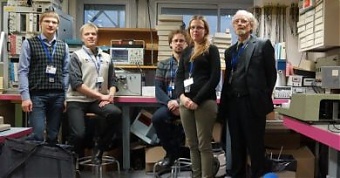Education and Science, Good for Business, Lithuania, Technology
International Internet Magazine. Baltic States news & analytics
Saturday, 27.04.2024, 04:05
Vilnius University produces unique machine for CERN
 Print version
Print version |
|---|
| Photo: vu.lt |
The system is based on the measurement of the radiation induced decrease of the charge carrier lifetime in pure silicon wafer pieces. A prototype apparatus was built in Vilnius and tested at CERN.
The second generation of the machine is presently located at CERN and further developments in the framework of the recently approved AIDA 2020 program are planned for the future. The aim of the new development project is to build a machine that can deduce the ionizing and the non-ionizing radiation flux of a radiation field from a single passive dosimetric sample.
"It is both, a great responsibility and honour to get enlisted into the CERN programmes, the teams have to have an exceptionally good repute for being invited to co-operate" – professor J. V. Vaitkus describes the possibility to co-operate with the CERN RD50 – "We were lucky to firstly prove our competence five years ago when we started working on CERN programmes together with the team of Glasgow University, while starting as of 2002 we were accepted into the list of partners under the Vilnius University name directly".
Dr Michael Moll, the leader of CERN, PH-Department declared, – "I highly appreciate the contribution of the Vilnius working group to the work of the RD50 research collaboration and the development of the radiation monitoring device for the CERN proton irradiation facility. On the RD50 side this will help us to gain a deeper understanding in the fundamental effects of radiation damage in silicon and on the irradiation facility side the work will result in a very useful and innovative fluence monitoring system with a very wide dynamic range. I hope that we can keep this fruitful collaboration upright".








 «The Baltic Course» Is Sold and Stays in Business!
«The Baltic Course» Is Sold and Stays in Business!

